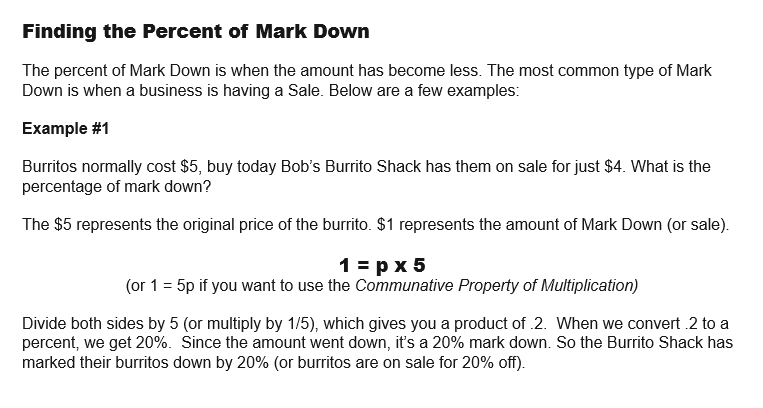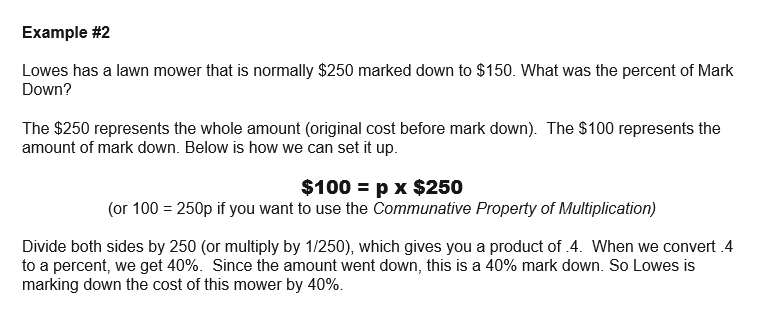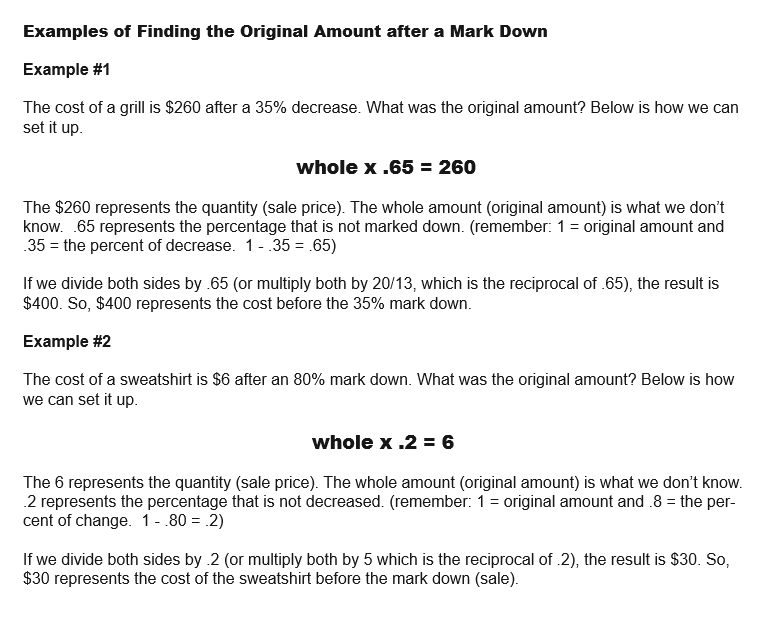In this blog, we will look at the relationship between Percentages, Fractions and Decimals. Each percentage has an equivalent fraction and decimal. One of the keys to working with percentages is the ability to master the relationship between these three. This will serve as your guide to decimal/fraction/percent nirvana.
Fractions to Decimals
When converting a fraction to a decimal, the thing to remember is that fractions are division problems. For example, most people know that the fraction 1/2 = .50 (or just .5). But why is it .50? Because when we divide 1 by 2 we get .50.
Other examples:
3/4 is 3 ÷ 4 which equals .75
1/8 is 1 ÷ 8 which equals .125
3/25 is 3 ÷ 25 which equals .12
Other examples:
.3 is read as three tenths so the fraction is 3/10 (does not simplify)
.35 is read as thirty-five hundredths so the fraction is 35/100, which simplifies to 7/20 (GCF= 5)
.125 is read as 125 thousandths, so the fraction is 125/1000, which simplifies to 1/8 (GCF = 125)*
*If you didn’t realize the GCF was 125 you could start by dividing (numerator and denominator) by a number that is common. For example 125/1000 ÷ 5 = 25/200 ÷ 5 = 5/40 ÷ 5 = 1/8.
What if you are not good at reading decimals? There is a pattern that you may notice as you convert a few decimals to fractions. You can write the number to the right of the decimal as your numerator (top number of the fraction). In the denominator, write the number “1” and the number of zeros equal to the amount of numbers to the right of the decimal.
If we use the decimal .13, we would write the number 13 on top of our fraction. On the bottom, we would write a “1” and two zeros because there are two numbers (the 1 & 3) to the right of the decimal. So .13 = 13/100
Decimals to Percentages
The thing to remember is that percentages are based on the number 100. To convert a decimal to a percentage we multiply by 100. So for example, take the decimal .21 and multiply that by 100. You get the answer 21. So... .21 = 21%
Other examples:
.75 x 100 = 75%
.8 x 100 = 80%
.03 x 100 = 3%
.125 x 100 = 12.5% (13% if rounded)
Students will begin to notice a pattern (some may call it a short cut). If you simply move the decimal two places to the right, you will get your percentage. This is something you want students to discover on their own (maybe with a little guidance).
Percentages to Decimals
Again, remember that percentages are based on the number 100. When we converted a decimal to a percentage, we multiplied the decimal by 100. Since we are now doing the opposite (percent to decimal), we are going to do the opposite of multiplying by 100 which is to divide by 100 (or multiply by 1/100). So, if we have 71%, we will divide the 71 by 100. The result is .71.
Other examples:
39% ÷ 100 = .39
12.5% ÷ 100 = .125
80% ÷ 100 = .8
5% ÷ 100 = .05
There is also a pattern with converting percentages to decimals. Simply move the decimal two places to the left to find the decimal equivalent of a percentage. What if you don’t see a decimal like in the example of 39% above? All whole numbers have a decimal (it is to the right of the number). So 39% has a decimal to the right of the “9.”
A decimal to the right of a whole number is similar to a positive sign on the number 32. It is not there, but it’s understood that it is there.
Percentages to Fractions (Actually percentage to decimal to fraction)
Converting percentages to fractions actually requires two steps. Fortunately these two steps are steps already covered. For example, if we want to write 81% as a fraction, we must first convert to the decimal .81. Next we are going to write the decimal as a fraction. We would read .81 as eighty-one hundredths. So we can write it as the fraction 81/100.
Other examples:
75% = .75 = 75/100 = 3/4
9% = .09 = 9/100
37.5% = .375 = 375/1000 = 3/8
Fractions to Percentages (Actually fraction to decimal to percentage)
Just like converting percentages to fractions, converting fractions to decimals also requires two steps. These are also steps already covered. For example, if we have 3/4 and want to write it as a percentage, we must first make it a decimal by dividing( 3 ÷ 4 = .75), then convert the decimal to a percentage by multiplying by 100 (.75 x 100 = 75%).
Other examples:
3/8 = 3÷8 = .375 x 100 = 37.5%
3/20 = 3 ÷ 20 = .15 x 100 = 15%
2/5 = 2 ÷ 5 = .4 x 100 = 40%



































